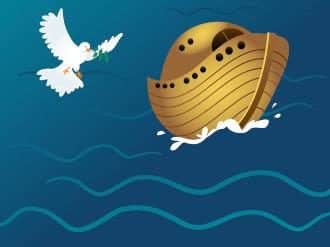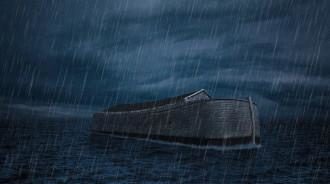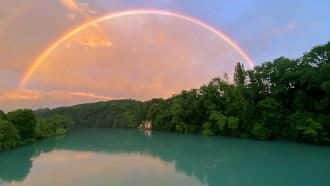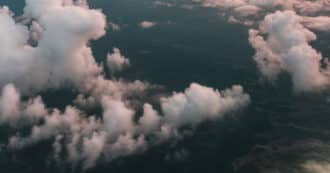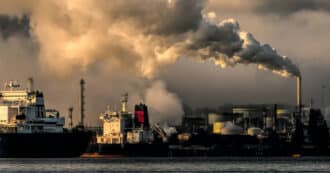By Lisa Cohen – Noah appears in Genesis 5:29, the son of Lamech, the 9th generation descended from Adam. Noah, father of Shem, Ham and Japeth, the originator of the vineyard, the image of a righteous man was commanded by God to restart the human race after a flood that would kill all his contemporaries and all living beings, except fish and the animals he was commanded to save: a male and female of every living species plus seven specimens of every kosher animal.
In the 1,656th year of Creation, 2105 BCE, the Great Flood came to destroy the earth and cleanse it of the evil ways of humankind, including theft, idolatry and incest.
God had commanded Noah to build an ark to house his family and the animals and gave Noah the exact dimensions: 300 cubits in length, 50 cubits width and 30 cubits height. It was to be three floors with the upper floor to house Noah and his family, the middle floor for the animals and the lowest floor for refuse that would become composted.
The Flood
Noah’s Ark took 120 years to build, giving time for the population to repent their ways of living which they did not. Read more in the ICSD blog here on why it took 120 years to build the Ark.
On the 17th day of the Hebrew month of Cheshvan, rain began to fall from heaven, whilst boiling hot jets of water gushed forth from the earth. For forty days and forty nights the rain continued submerging all of earth until the water was 15 cubits deep.
After the rain ceased, the waters continued to rage for another 150 days, before slowly receding, allowing the ark to come to rest on the Mountains of Ararat, in Turkey.
Noah sent out a raven to assess the situation but the raven stayed near the ark. Noah then sent out a dove on three separate missions. The first time the dove too stayed near the ark, but on the second trip it returned with an olive leaf, showing new growth had begun, and on its third trip the dove never returned having found a new home on dry ground.
Noah Emerging From The Ark
On the first day of the Hebrew month of Tishrei 1,657 (2104 BCE) the water had subsided. Two months later on the 27th of Cheshvan, the ground had dried and Noah and all of the Ark’s inhabitants emerged to the newly cleansed earth. Noah had spent 365 days in the Ark – one complete solar year!
Noah’s Legacies
The Noah narrative leaves us with many important legacies.
Firstly we have God’s promise and assurance of nature’s protection from any future catastrophe made by God. God made the rainbow to remind us of His promise. This clearly does not include nature’s protection from human made catastrophes!
Secondly, Noah and his family are commanded to procreate and fill the Earth. Therefore, history, and the entire human race, is descended from Noah’s three sons and their wives.
Thirdly, God also gave them permission to eat certain animals, which had been forbidden up until this point.
Finally, we also learn that with all the manure created by a year on the Ark, Noah developed agriculture and was the originator of the vineyard.
Noah died at the age of 950 years, after witnessing the most catastrophic event of God wiping out all life from earth. We have so much to learn from Noah and the Biblical flood story.
In The Eco Bible, we can see how Noah had a great impact on contemporary environmental issues that we are still challenged by today.
Noah’s Green Building
There’s a suggestive hint about building sustainably in Genesis 6:16, where it says “Make an opening [tzohar] for daylight in the Ark and terminate it within a cubit of the top. Put the entrance to the Ark in its side; make it with bottom, second, and third decks.”
Rashi offers two possible meanings of tzohar, an “opening” or a “stone that emits light.” The Ark was a “green building,” with a window for natural lighting from the sun, a whole floor dedicated to composting of animal waste, and wood from forests Noah planted, according to the Midrash. Studying the design of the first Divine-commanded building could teach us about Divine green building standards.
The end of this verse states that God commanded Noah to build the Ark with three levels. The Talmud explains why. Humans were to be on the top deck, the animals in the middle deck, and their manure stored at the bottom. Why store the manure? After all, it could have just been thrown into the sea! As farmers in the Midwestern United States learned after the 2019 floods, “Flooding drains nutrients out of the soil that are necessary for plant growth as well as reducing oxygen needed for plant roots to breathe and gather water and nutrients.”
Noah Created Biblical Fertilizer
This may be the first Biblical reference to organic fertilizer. Recent years have seen multiple unintended explosions of ammonium nitrate. In August 2020, 2,750 metric tons of ammonium nitrate exploded in Beirut, killing 157 people, wounding 5,000, and causing 300,000 to be homeless. Large explosions also occurred in Tianjin, China (2015) and Texas (2013). These disasters reveal another impact of the widespread use of ammonium nitrate.
The Ark was a “green” project in Biblical times. Today, about one- third of US building projects are considered “green,” saving an average of 15 percent on water and electricity costs compared to conventional buildings. Natural lighting, solar power, and water recycling are just some of the many architectural and design features that ensure buildings will consume less of nature’s resources.
Noah as Earth Steward, by Shimshon Stüart Siegel
Take a deeper look at Genesis 6:19, where it says “And of all that lives, of all flesh, you shall take two of each into the Ark to keep alive with you; they shall be male and female”. We are seeing Noah through the eyes of the rabbinic commentaries, discovering a man who spent his life caring for nature and spreading Divine awareness. This fresh look can provide us many lessons as we strive to bring our world back to a state of holy balance. What can we learn from Noah’s efforts?
We can learn that caring about the environment requires patience and forethought. The Midrash says that 120 years before the Flood, Noah actually planted the trees from which he would take the wood for the Ark. (No old-growth logging here!) Aware of the massive resources that his project would demand, Noah tried to be as self-sustaining as possible.
Noah Created The First Biodome
Another lesson we can learn from Noah is that it helps to see the world as a “closed,” integrated system. Noah and his seven-person crew maintained a sort of proto-Biodome inside the Ark, struggling to preserve a functional level of ecological balance in the most challenging of situations. Within such a system, every action has a significant impact and ramifications, and individual elements can be aligned to strengthen and assist one another.
In modern times, this ecological balance is demonstrated by walking, riding bikes, and using public transportation in congested areas. These individual decisions collectively reduce pollution while easing traffic jams. Partly as a result of the coronavirus pandemic, cities are exploring how to permanently block off more areas for walkers and bikers traveling to work or getting outdoors after work and on weekends. Less traffic and cleaner air reduce many kinds of human health risk from both accidents, pollution, and communicable disease. Individually, these very same choices can reduce personal stress and keep us more fit as well.
Noah as an Agricultural Pioneer
After the flood, Noah reinvented himself as an agricultural pioneer. The Midrash explains that Noah revolutionized farming techniques to soften the backbreaking toil that had been the way of the land since the sin of Adam and Eve. By easing the burdens on people and the soil, he truly earned the meaning of his name, “rest.”
Overall, Noah’s relationship with the land was harmonious and productive, not adversarial or injurious to the planet for his own well-being. Like Noah, modern farmers can promote agricultural techniques, such as organic farming, that keep consumers healthier and keep the land fruitful, both literally and figuratively, for future generations. Also we must not fill our breadbasket at the expense of suffering by farmworkers – such as their exposure in the fields to toxic pesticides.
For Noah, the Ark was an unfortunate but necessary solution to a global crisis. Even when all signs were grim, he maintained his faith, greeting every challenge with further innovation. So, too, must we continue to strive for a better tomorrow, educate others about environmental issues, and ensure that our actions on every level make a difference. When we step outside after a rainstorm and see the rainbow in the sky, we remember God’s promise to Noah, and we can believe and know that we are not alone in our efforts.
Noah Caring For Animals
Malbim (Rabbi Meir Leibush ben Yechiel Michel) looks at Genesis 6:21 – “For your part, take of everything that is eaten and store it away, to serve as food for you and for them.” He explains that God is telling Noah, “Don’t expect that each animal will bring food for itself in the same way that it hides away food during the summer for the winter months, but rather, make sure that you bring all the necessary provisions with you on to the Ark.”
In other words, due to the disruption of animals’ usual behavior in their ecosystems, Noah becomes responsible not just to bring the animals onto the Ark, but to guarantee their survival by supplying appropriate food for all of the animals, birds, and insects. In our times, ecological devastation has a similar impact and puts similar demands on humans.
After catastrophic fires in Australia wiped out eucalyptus forests, leaving any surviving koalas without their only food source, human rescuers are relocating koalas to other eucalyptus areas that were not burned.
The Flood, Rainbows and Responsibility
Rabbi Samson Raphael Hirsch explains that the symbolism of the rainbow is its multiple colors in one cohesive structure. He starts from Genesis 9:13 – “I have set My bow in the clouds, and it shall serve as a sign of the covenant between Me and the earth.” God’s pact of peace with humankind and all of creation is represented by this eternal symbol of diversity. Today we know that our global ecosystem is extremely complex and interlinked, even beyond what humans can currently comprehend. Our actions in diverting a single river or allowing the use of a single refrigerant chemical can have devastating effects on aspects of the planet we don’t even know about – including even species not yet identified – that could affect us for generations to come.
Nachmanides teaches that the rainbow signifies an upside-down bow and serves as “a reminder of peace.” The feet of the rainbow are bent downward to show that the Heavenly “shooting” (the torrential rains) has ceased.
Rabbi Shlomo Riskin explains the meaning of Nachmanides’ teaching: “Ancient cultures fought their wars with the bow and arrow, and the side which surrendered, pursuing peace instead of war, would express their will to do so by raising an inverted bow that the enemy could see. Similarly, God places an inverted bow in the heavens as a sign that He is no longer warring against humanity.”
The rainbow testifies to the Creator’s intention for life on our planet to continue to exist. It is a sign that God desires the existence of the world and not its destruction.
Rabbi Riskin continues that the symbolism of the rainbow extends beyond God’s commitment – to encompass humans: “The rainbow is a half-picture, lacking a second half to complete the circle of wholeness. God can pledge not to destroy humanity, but since He created humanity with freedom of choice, He cannot guarantee that humanity will not destroy itself.”
Yet the rabbis make clear that God does not want us to destroy creation either.
Will Noah Save Earth Again?
At present, humanity is emitting over 36 billion tons of CO2 per year into the atmosphere. In the past 800,000 years, atmospheric concentrations of CO2 did not exceed 300 parts per million (ppm). Yet people have dramatically increased the concentration of CO2 in the atmosphere in the past 200 years, to 417 parts per million and rising every year.
A consensus of climate scientists understands that humans are directly causing climate change. Through our consumption, it is as if we are shooting carbon arrows into the atmosphere, inadvertently waging war on God’s creation.
In Israel, one first sees rainbows after the Jewish New Year and Day of Atonement, when the winter rains begin to fall in October. According to the Ziv HaZohar commentary, the rainbow as a whole reminds us to turn our hearts to improve our actions. Perhaps the timing of the rainbow’s appearance, soon after the period of repentance, can motivate each of us to keep improving ourselves and become better servants of the Creator and collective stewards of creation.
* Featured image source


